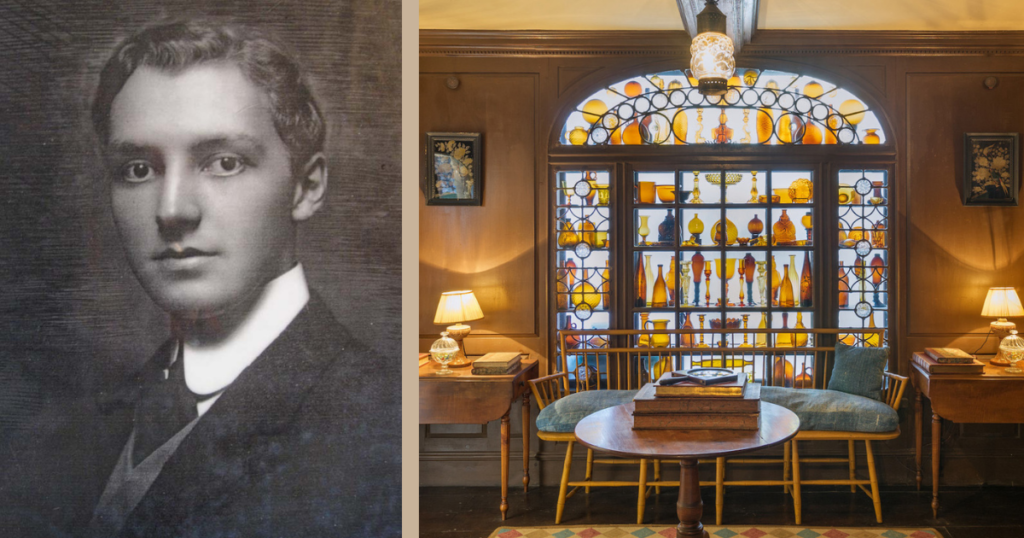
Apple | Spotify | Stitcher | Transcript | Email
In the second episode of season 3, Kendra brings you to Beauport, the Sleeper-McCann House in Gloucester, Massachusetts. Henry Davis Sleeper was one of the first professional interior designers in the US. His work used salvaged material, color, and light to create spaces overflowing with personality. Beauport, built in 1907, became a portfolio of his work, with 5 dining rooms designed to impress and entertain. Barely anything has changed in this time capsule of his work.
Henry Davis Sleeper was a gay man with a close circle of friends and neighbors. In this episode, we go through the rooms in his home and tell his story: from his early relationship with Guy Whetmore Caryll, to his friendship with A. Piatt Andrew, and a mouse encounter with Isabella Stewart Gardner. Henry Davis Sleeper lived from 1878 to 1934.
Thank you to Historic New England, Site Manager Martha Van Koevering, and PR Officer Susanna Crampton. You can book tour tickets to see Beauport in person.
Images referenced in this episode can be found below courtesy of Historic New England. You can find a full transcript of this episode.
The music for our show is by Tim Cahill. Check out his new album, Songs From a Bedroom.
If you like this episode and want to hear other episodes like it check out: Alice Austen House, Lyndhurst Mansion, Hill-Stead Museum, Steepletop.
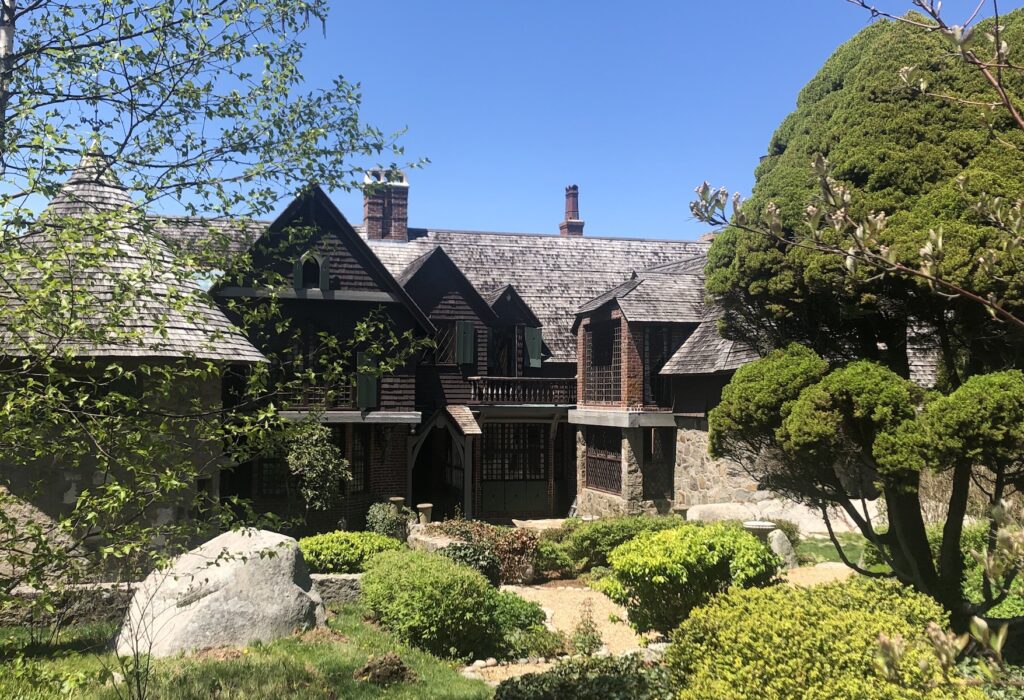
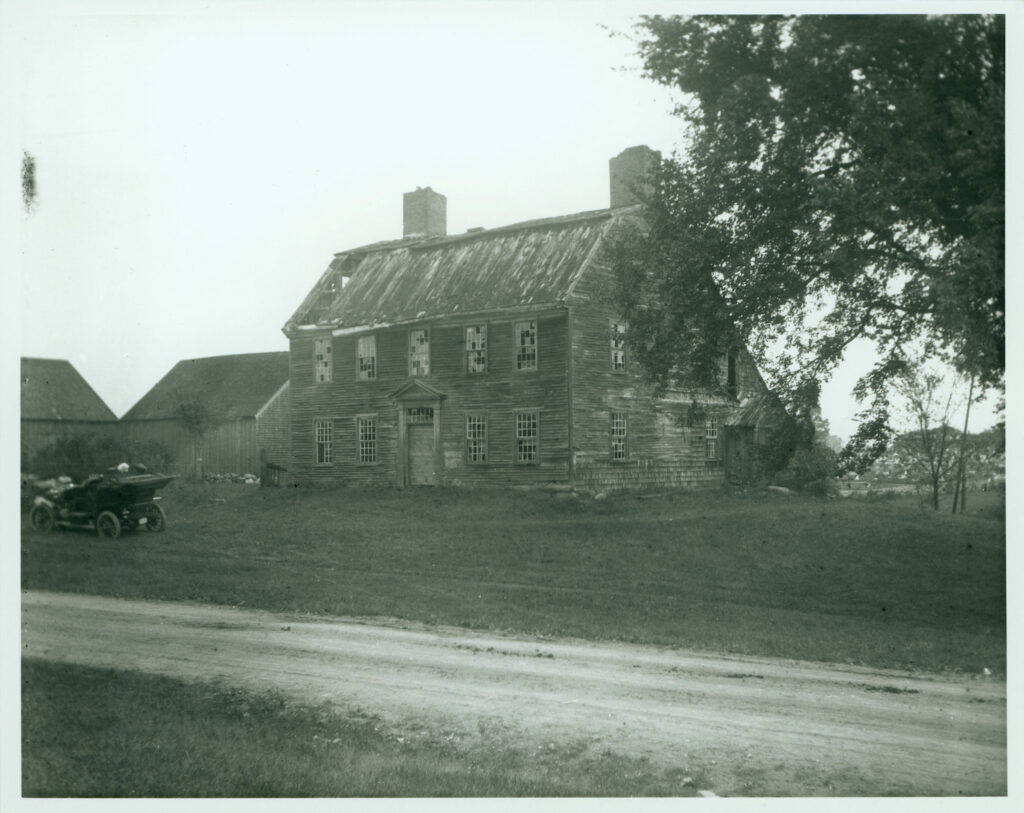
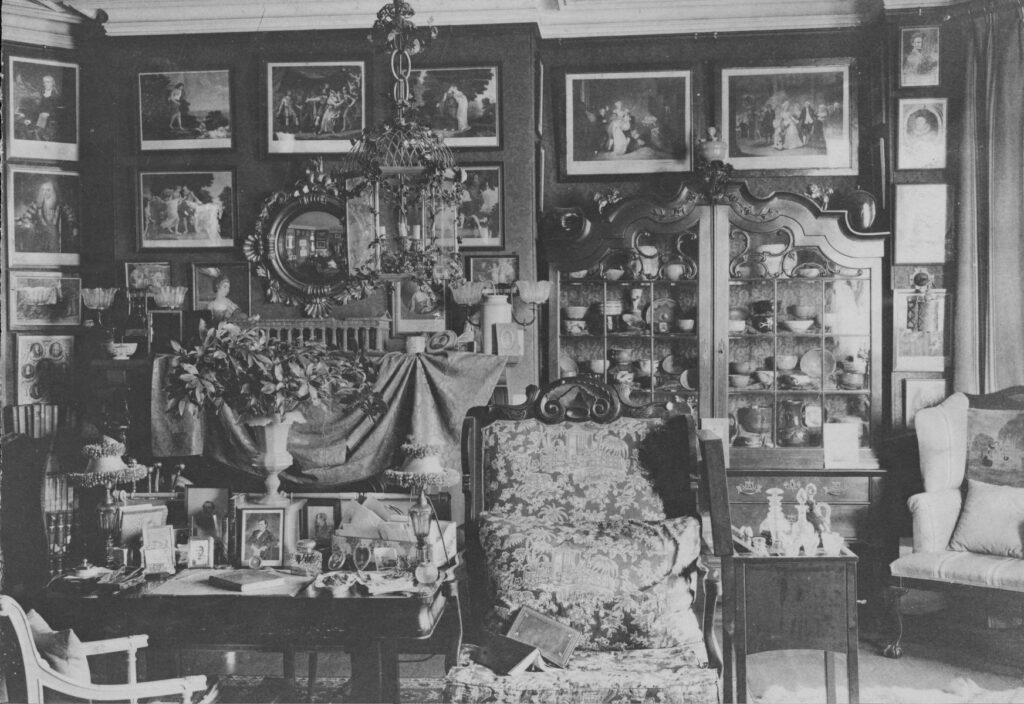
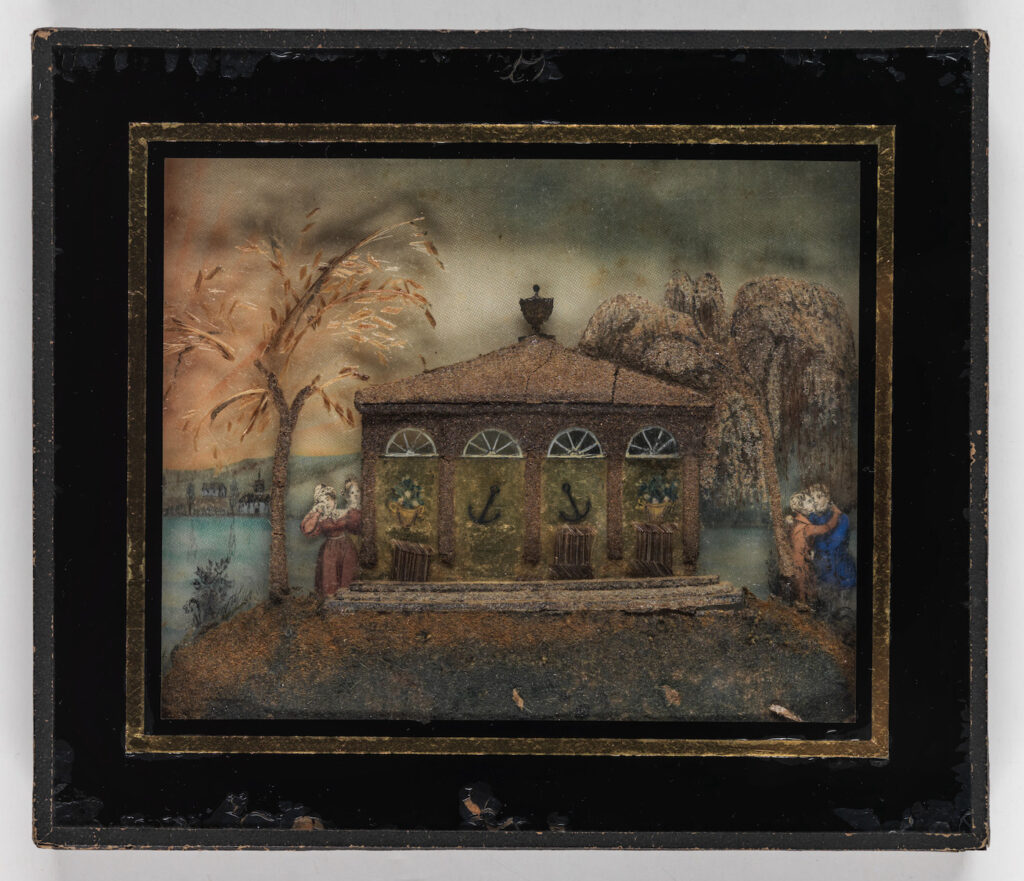
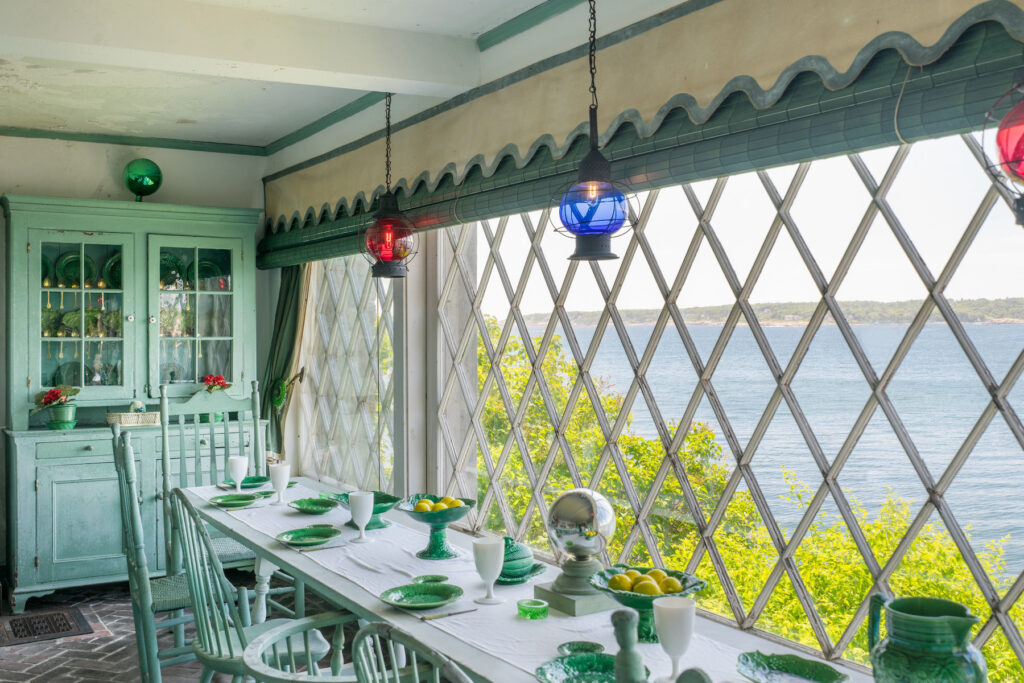
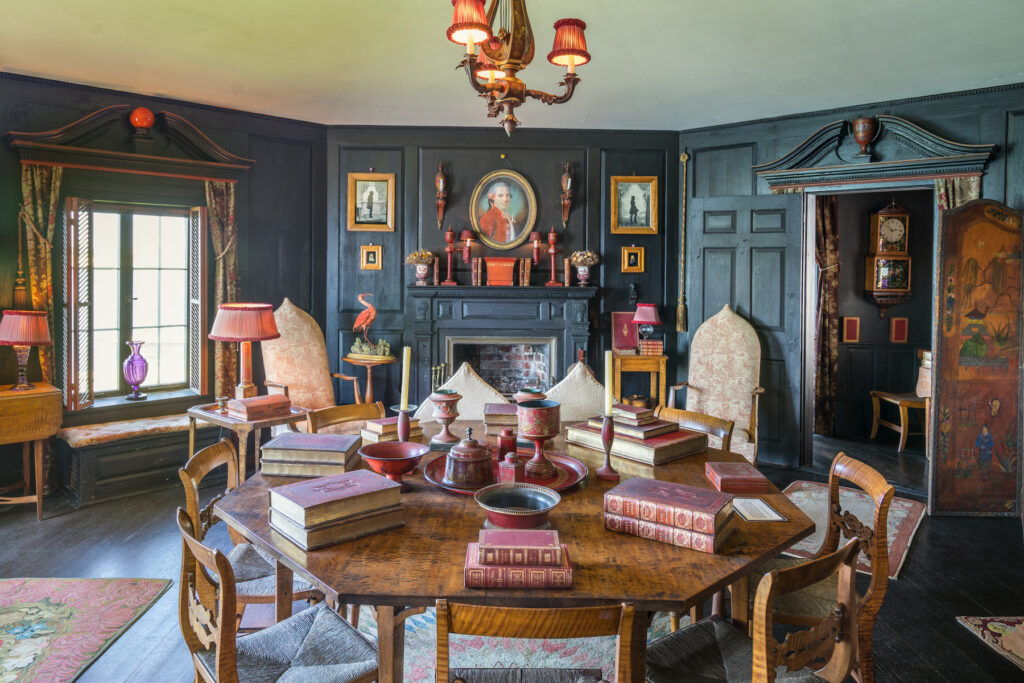
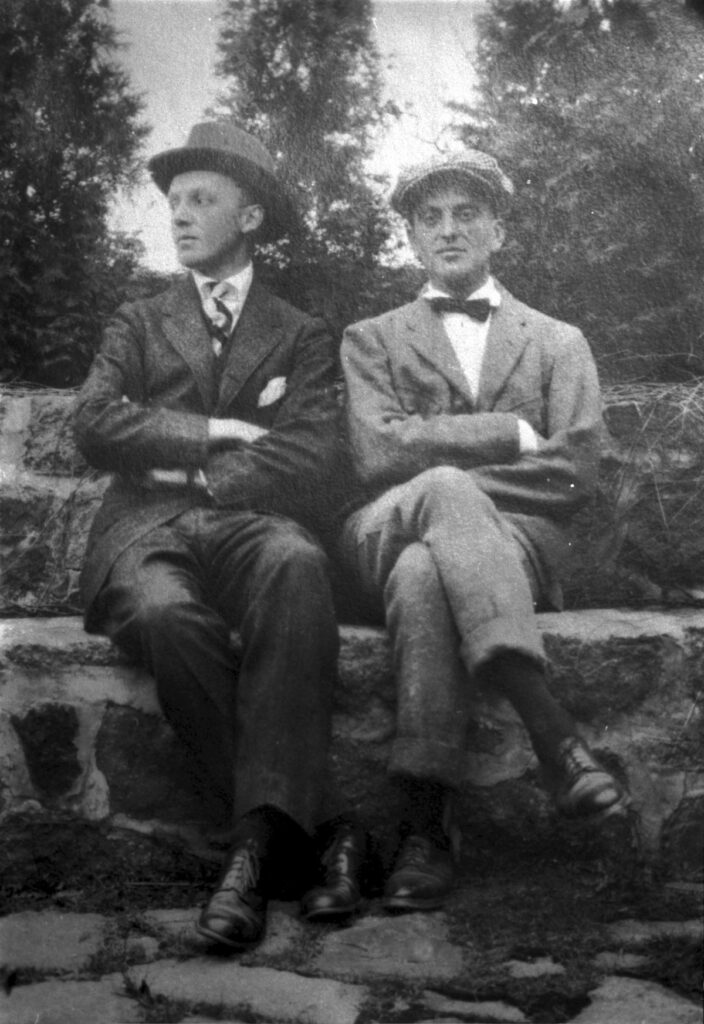
Below is a transcript for S3E2 of Someone Lived Here at Beauport, the Sleeper-McCann House in Gloucester, Massachusetts. If you have any questions about the show or suggestions on how to make it more accessible please reach out at someonelivedhere@gmail.com.
Kendra Gaylord (00:00):
This week we’re at Beauport in Gloucester, Massachusetts. The homes interior was designed by Henry Davis Sleeper one of the first professional interior designers in the US. His work used salvaged material, color and light to create a spaces overflowing with personality. Barely anything has changed in this time capsule of his work. But when he lived here, he was a gay man, with a close circle of friends and a house that launched his career.
Martha Van Koevering (00:41):
Welcome to Someone Lived Here, a podcast about the places people called home. I’m your host Kendra Gaylord. We’re standing outside this house on Eastern Point, overlooking Gloucester Harbor. Normally, here I say the type of house it is, but its not that simple with this one. When Henry Davis Sleeper originally had the home built in 1907 it started as a shingle style summer home. He used an architect fresh out of school, Halfdan Hanson. Every few years a new addition to the house would be added. The book tower in 1911. The Pine Kitchen in 1917. The Octagon Room in 1921. While he lived there it was always changing. And although it’s one house, it has parts of many other homes living within it. We’re walking down the stone path into Cogswell Entrance Hall with Martha Van Koevering the Site Manager at Beauport.
Martha Van Koevering (01:46):
So we can go. And if you like, yeah.
Martha Van Koevering (01:50):
So this is the main entrance to the house. This room is known as Cogswell entrance hall. And even with all the changes Henry Sleeper made this, this has always been the entrance. So there’s a photo that we show Henry Sleeper was out for a drive with his neighbor. Piatt Andrew. And of course their good friend from Boston, Isabella Stewart Gardner.
Kendra Gaylord (02:15):
Yes, that’s The Isabella Stewart Gardner of the Isabella Stewart Gardner Museum.
Martha Van Koevering (02:20):
They passed this house and they took a photo of themselves that day. Cause that’s the car they were driving. Henry Sleeper ended up making an offer to purchase the interior paneling from this house to use. Then in the new house he was going to build. And this is one of the rooms where he used the paneling from this 18th century house. And of course he’s reconfigured it and created his own room with that paneling and painted in a lovely yellow ochre color.
Kendra Gaylord (02:48):
This isn’t the only room that uses parts of that paneling. It’s also in the central hallway, which is where we’re heading now. This hall has doors leading in every direction and a stairway to the second floor, but there’s only one thing that captures your eye in this room.
Martha Van Koevering (03:04):
But the significant thing here is this fabulous display of 130 pieces of Amber Glass. He has pieces there that have significant value and importance and he’s placed them right alongside pieces that, you know, he probably picked up in a dime store, but it has more to do with whether or not it had the right color and shape to fit the display that he was creating. The other nice thing is that the display case itself, he repurposed, it was originally a doorway in a home in Connecticut and he brought it here and installed it to use, to display his glass. And often, first time visitors think that the frosted glass at the back, you know, might be part of an exterior wall. It isn’t, it actually leads to a little pantry, a little pastry room off the kitchen and Henry Sleeper put up a skylight up behind that glass and two mirrors so that he could capture natural daylight to always backlight his display of glass. So this is really classic Henry Sleeper as an interior designer using light and color and arranging collections and architectural salvage all in one piece. and this is, this is exactly what he was known for.
Kendra Gaylord (04:23):
Before we go upstairs or look at any of the five themed dining rooms. I want to learn more about who Henry Davis Sleeper was and to do that. I think it’d be best to go to his original bedroom in this house.
Martha Van Koevering (04:36):
And we’ll go through the next door, a couple of steps into what was Henry Sleeper’s bedroom. This side of the house was also where all of his friends lived. So his mom had her space upstairs, a lovely space over there and that side of the house, but this was his bedroom and his sort of private access.
Kendra Gaylord (05:06):
She mentioned all of his friends living on this side of the house, that group called themselves, DABSville with each letter representing their last names. Joanna Davidge had a finishing school in New York and had a cottage called Pierlane. Next to her house was A Piatt Andrew with his house Red Roof. Then Cecilia Beaux, a portrait painter, the S in DABSville was shared by both Henry Sleeper and Caroline Sinkler. She lived in a house named Wrong Roof. She was slightly poking fun of Red Roof. This house was closest to Beauport and the room we’re in now has some call-outs to her.
Martha Van Koevering (05:46):
She had a somewhat sad story. It had a house in Philadelphia and was engaged to be married. And her fiance fell through a frozen river just in the week or days leading up to the wedding. And so she went into mourning and went through traditional mourning phases. And somehow she liked lavender so much. She got stuck in lavender and she became known as the Lavender Lady, which is why Henry Sleeper put a little bit of lavender glass in these windows here. And he also planted lavender just outside this window, just as a little nod to Caroline.
Kendra Gaylord (06:25):
When Henry started building this house he was 29 years old. But he had hoped to have his own property long before he was able to build it. There is an interior photo of his families home on Beacon Street in Boston. The photo has no people in it, but its expertly posed. Books are partially opened up on a chair and Henry Sleeper’s desk is in full view. There are a few portraits on his desk. A photo of his late father and then a framed photo of Guy Whetmore Caryll. Guy was a writer who had articles published in the New York Times and became famous for his parodies of classic stories like Fables for the Frivolous and Grimm Tales Made Gay. Henry and Guy were close. Guy wrote a book called Far from the Maddening Girls about a young man, desperate to avoid marriage. He decides that the only socially acceptable way to be a bachelor is if you can build yourself a house and do it so well that everyone believes you when you say you don’t need a wife and on the dedication page, it reads “In furtherance of an unfulfilled intention. This book is dedicated to the authors, dear friend, and comrade Henry D Sleeper” Guy wasn’t alive to witness Henry fulfill that intention. He died before the book was published at the age of 31 from complications after a fire in his home. Before we leave this room, we’re going to look at one more thing. That’s tucked away.
Martha Van Koevering (07:55):
Tucked away. So as we walked past a little reading nook, if you go in there, you can go. so this is Henry Sleepers desk up above there. You’ll see a framed mourning style picture.
Kendra Gaylord (08:08):
Its looks similar to mourning embroidery that was popular in the early 1800s. This piece has all the classic hallmarks, a woman crying, an urn, willow trees in the background. But on this painted collage on the right are two men embracing, their faces touching. We’re now going to see one of those 5 dining rooms, I mentioned and learn a little bit more about his neighbor A. Piatt Andrew.
Martha Van Koevering (08:37):
This room is known as Line Brooke Parish and it gets its name because we believe the paneling came from a 17th century house in the Line Brooke Parish district of a neighboring town, Ipswich. Here, you know, Henry Sleeper has taken this paneling and really made a room that looks like a 17th century room. He went ahead and, and electrified all these fabulous lanterns, including, you know, the pewter tin lanterns that you’ll see more of throughout the house. He wanted a little more light than maybe a traditional 17th century room. So he added this bay window to be able to allow some light in here. So this is definitely an evening room that really comes alive at night and it becomes a real warm, cozy.
Kendra Gaylord (09:25):
This dining room was one of the original rooms here and Henry would invite his neighbors for parties. But how do you end up living next to these cool friends? The answer is A. Piatt Andrew.
Martha Van Koevering (09:40):
When Henry Sleeper met him, he was a professor of economics at Harvard, and he had already built his house out here in 1902. And he really actively, I think cultivated a group of people. Like-minded people that he wanted to be neighbors
Kendra Gaylord (09:57):
Piatt was a magnetic person. And one of the people we know was drawn to him was Henry. In a letter sent right before Christmas you can see how much Piatt meant to Henry. “I tried to figure about where you must be as the hours sped by on Saturday. But I knew I couldn’t calculate very accurately on the B & A. It seems strange when I woke up next morning to have to add so many miles to the distance, the doorbell has rung many times and many things have arrived, but nothing has come or will come, which could please me like what I got last Thursday. I haven’t had it off for an hour since I put it on that afternoon and I shan’t. I haven’t loved a present so much since I was a child. Every night, it goes into the pocket of my pajamas. Mother said yesterday, she should think I would value it more than any of my other presents because of the thoughts shown in the choosing. But she couldn’t guess quite how much more I thought of it than of the other things. I’m writing now in the room where I opened it. Do you remember? Well, goodnight and good luck to you at Madison. I’m just going to get out a map to see exactly how much further you have to go. My love to you and to yours HDS.” The challenging part of these letters is they are only one sided. We don’t know what Piatt wrote in response… we only know that on Christmas Day, Henry wrote him back saying, “I awoke this morning very early & very happy, thanks to a wonderful surprise which came from you last night. It was such a dear letter that, although it is not yet dayligh, I must begin my Christmas now by telling you that I loved & appreciated it.”
Kendra Gaylord (11:48):
Piatt and Henry continued their friendship and their correspondence, but as Henry settled in at Beauport and Piatts career took him all over the world, the letters began to shift to housekeeping while Henry kept an eye on Red Roof. Which brings me to a letter that I never expected to read. I mentioned earlier how Isabella Stewart Gardner was a close friend.
Kendra Gaylord (12:48):
When I think of Isabella Stewart Gardner, I often find myself drifting to the more recent history – her muse the heist, the frames still empty. But when you look into her, you find a character larger than life: she was rumored to have a lion she walked in the city. She hosted a boxing match at her home. She was said to greet her guests perched on a tree branch. She was fun and eccentric, which could not be said for other wealthy Bostonians. But how much of that was rumors and performance. She burned most of her personal correspondences before she died and you can now buy a mug at the Isabella Stewart Gardner Museum with her quote, “Don’t spoil a good story by telling the truth”
Kendra Gaylord (12:48):
When you look through the guest book from Red Roof you see her large signature on so many of the pages and the photos throughout look like a good time. She was so welcomed at Red Roof that she would often stay their during the summer even while Piatt was out of town traveling. Which brings me to the letter in question sent by Henry on August 20, 1908. “Red Roof is well – only one more mouse caught though the traps are kept set. The one that was caught, ran across Mrs. Gardner’s face in the night before he found the trap, which proved his tomb.” The rest of the letter, discusses house finances and event invitations. But as someone who works hard to forget some of the creepy things that have crawled over me at night, there is a nice reminder that Isabella Stewart Gardner was just a person. And also that maybe Red Roof needed a cat.
Kendra Gaylord (14:06):
We’re now going to see another dining room in Beauport, Pine Kitchen. It’s called Pine Kitchen and was added on 10 years after the house was built. It was Henry’s idealized interpretation of an early American kitchen.
Martha Van Koevering (14:06):
This room is also another good example of his use of architectural remnants. The paneling from this room for this room came from his mother’s ancestral home in Pembroke, Massachusetts. And so you’ll see, for instance behind there’s a portrait of her here Maria Westcott Sleeper, and the panel behind her, you can see was originally a doorway. And so the hardware has been stripped and it’s been used instead here for paneling.
Kendra Gaylord (14:35):
This feels like a good time to talk about Henry’s family. Henry was the youngest of three brothers in a prominent Boston Family. His grandfather had made money in real estate and clothing manufacturing and was one of the co founders of Boston University. But Henry seemed closest with his mother. She spent many summers here in Beauport. And one of their favorite activities was antiquing.
Martha Van Koevering (14:59):
And he wrote about the many hours that he spent with his mother sort of searching for items and, of happy memories of doing those things. So she probably thoroughly enjoyed the house that he was building and, and her time in it, sadly,
Kendra Gaylord (15:15):
Sadly, she died the same year. This room was built and she didn’t get to see the remarkable career it started.
Martha Van Koevering (15:21):
This is the room that began to really put him on the map as a designer. It’s the room that was quite trendy at the time that people were copying and asking him to recreate for them. One of those people was Henry DuPont and he was a collector of American Decorative Arts. And he visited Beauport and commissioned Henry Sleeper to first do work on a summer home, and then also to do some work at Winterthur. And that really catapulted Henry Sleeper to national fame.
Kendra Gaylord (15:53):
Although this room was called Pine Kitchen, it wasn’t the actual kitchen, which is great cause cooking on a fireplace hearth seems really bad for the back.
Martha Van Koevering (16:02):
Yeah, we’ll go from, into the real working kitchen of the house. What always strikes people is how bright and light it is.
Kendra Gaylord (16:14):
The brightness is pretty surprising since this room has no exterior walls, but it does have skylights and a lightwell. The room also has a very, very large banner that we’ll get into in a minute.
Martha Van Koevering (16:28):
Of course, this is really where, you know, the workings of the house were. So Henry Sleeper was lucky enough to employ a woman as head housekeeper in 1919. Her name was Mary Swanson and she came soon after his mom passed away and became the head housekeeper. She and her husband, George had two boys and they had some rooms above of some stairs just above Pine Kitchen, where they were able to stay in the summertime and in the winter they had their own home in East Gloucester. There’s a nice story too, about this banner when we were redoing this space, the space was restored in the early 2000s. We did an oral history with one of Mary’s sons, and he came and toured the house and visited. And this banner wasn’t hanging here at the time. And he asked where George Washington was. And apparently this had been in storage, but nobody really knew where it went. And so it was nice. He remembered sitting here having breakfast with George.
Martha Van Koevering (17:34):
That’s, right, it’s a nearly 10 foot banner portrait of George Washington. That’s just casually in the kitchen. We’re now going to move into a room whose name will become pretty self-explanatory.
Martha Van Koevering (17:46):
So we now have stepped into a room, the Octagon Room and you can see why. Everything in here has eight sides. The table has eight sides and eight chairs. The rug underneath the table has eight sides. The ceiling is scored in eight and even the doorknobs, the amethyst glass door knobs are eight sided. So this is clearly the Octagon Room.
Kendra Gaylord (18:10):
The room also has a second name, the souvenir difference from which will make more sense. Once we talk about what Piatt and Henry did in WWI.
Martha Van Koevering (18:17):
So initially Piatt went to France into Paris in the end of 1914 because the US had yet to enter the war effort. And I think he was looking for a way to contribute. And so he had a contact at the American Hospital in Paris, and he saw and identified a need. And maybe , you know, was asked to help find a solution for transporting wounded soldiers from the front line, back to the hospital. Piatt founded the American Field Service, which was an, a volunteer ambulance service that worked to ferry wounded soldiers from the front lines back to the hospitals. And Henry Sleeper initially did all the fundraising and recruiting of the volunteer drivers from the Boston area and, and elsewhere to help support the effort. And so towards the end of the war, Henry Sleeper went over to France. It was after his mom passed away. He worked as the director of the headquarters of the American field service in Paris. There he would work and organize until the war ended, both Piatt and Henry received the Legion of Honor for their work. And Henry stayed on a few more months in France.
Martha Van Koevering (19:32):
And he wrote a letter to his good friend, Isabella Stewart Gardner, as he was returning to the U S in 1920, he writes, “I’m planning to make a new room at Gloucester. The new room will be octagonal in shape and all my red painted toleware that I brought back from France. Of course, I have all the details visualized and am enjoying it accordingly.”
Kendra Gaylord (19:56):
The room that came together is full of purples and reds. The walls are a deep purple that have darkened with age. There is a water view, but in this room it feels in the background. Unlike the next dining room we’re going to. Where the rest of the house acts so nonchalant about being on the water, Golden Step room is almost bragging. The room has three ship models of varying sizes. All the tables and chairs are painted a seafoam green. There are mermen framing a window that look like they belong on the bow of a boat somewhere.
Martha Van Koevering (20:31):
The best thing though about the whole room is the large window in the middle is on pulleys. So it can simply be lowered into the foundation of the house. So there’s nothing to separate you from a lovely sea breeze. And it only struck me last year. I hadn’t thought about it before, but this is part of the wing that he added after he returned from France after World War I. So around 1921, he himself of course, had lived through the 1918 pandemic and had become sick. And in 1918, and I’m sure a few years later, people were still looking for lovely ventilated spaces to enjoy with family and friends, especially meals, right? So this may have been a direct result of that period.
Kendra Gaylord (21:24):
Before we leave this room there is an object in here that is worth taking a closer look at. You may remember that in the kitchen there is a large banner of George Washington and in the main hallway there is another statue of him attached to the heater. On the stairs right beside this room we’re in now there are miniature busts of founding fathers all around a bookcase. But in this room a Haitian revolutionary is getting a much different treatment.
Martha Van Koevering (21:49):
So this is actually a figure of Toussaint Louverture. So he’s the Haitian revolutionary war figure. And here, he’s in the figure of a mechanical dinner bell. It’s a really great example of how we have two revolutionary war heroes depicted in the house. We have George Washington in Central Hall given a neoclassical treatment, and then we have Toussaint Louverture turned into a dinner bell.
Kendra Gaylord (22:19):
We’re now going to go upstairs to the Master Mariners room.
Martha Van Koevering (22:28):
This is actually the last full room Henry Sleeper added in 1925. He, this is a tribute to the Gloucester master Mariners association. And this is where Henry Sleeper has nautical and maritime themed collections. You know, he was really setting up his rooms at this point to be staged sets in many ways, this room photographs beautifully, but it seems to have less functionality. You know, his lighting, for instance, he drilled the hole through the table because he wanted that lamp right there. But of course, no, one’s going to sit here.
Kendra Gaylord (23:05):
It does look a lot like a set and that makes sense. In the following years, Henry would start doing jobs on the west coast, creating interiors for Hollywood actors homes. I was curious if he ever did movie set design.
Martha Van Koevering (23:19):
I’ve read things written at the time that referred to him as a designer stage that, but I’ve never found record of that. So again whether that’s something he was, people thought he might move into whether he was beginning to dabble in it, but we don’t have, we don’t have specifics on that.
Kendra Gaylord (23:40):
Four years after finishing this final room Beauport was featured in Country Life paired with paintings of the rooms capturing their color and depth. The editor wrote, “This house is paramount perhaps as a composition. It’s creator is more than a mere collector. He is more than an antiquarian. He is at heart an artist.”.
Kendra Gaylord (24:05):
Five years later, Henry became sick while working on the west coast. He came home to Boston. At age 56, he died of leukemia. Henry sent one last letter to Piatt, this time dictated. “My very dear Piatt: I was deeply touched by the thought and perfume your letter brought.Memories of so many consecrate and happy days, for nothing was ever more dear to me than Red Roof. I hope we will meet again before many weeks. Meanwhile bless you always.”.
Kendra Gaylord (24:41):
Before we leave Beauport, I want to look at one last room downstairs that tells the story of how this home was so well-preserved.
Martha Van Koevering (24:50):
So this is a room known as the China Trade Room. It was originally a Medieval hall. So Henry Sleeper had dark paneling on the walls. He had a large tapestry above the fireplace, and this room stayed like this until about 1923. When Henry Sleeper acquired this wallpaper, the wallpaper is amazing because it’s hand painted from China and it dates to the 1780s. It was originally ordered by a man named Robert Morris, who was a signer of the Declaration of Independence. And he ended up going into debt himself. And so when this wallpaper came over from China, he was unable to accept it. So the paper stayed all rolled up in its original packaging and it was untouched for over a hundred years. It was in the attic of the Elbridge Gary House in Marblehead. And somehow Henry Sleeper must’ve heard about it and he decided to purchase it and completely changed this room from medieval hall into a China Trade Room. When he redid this room, though, it still didn’t look like this.
Kendra Gaylord (26:10):
When Henry died the home was left to his brother who then sold it to Helena Woolworth McCann with all of its contents inside. A friend and former client Henry Francis duPont reached out to her with the following, ““Naturally the minute you take things out of this house, or change them about, the value of the collection does not exist, as really the arrangement is 90%. He went on to call out the China Trade Room as bad and therefore fine to change. So the wallpaper stayed the same and a chippendale sofa and Waterford chandelier was installed.
Kendra Gaylord (26:46):
But that means that in every other room, every wall panel or amber glass vase is where Sleeper intended it to be. Both of the McCann’s died within six years, and per their wishes, their children donated the home and all it’s contents to an organization that is today known as Historic New England. I mentioned Mary Wanson earlier as the head housekeeper of Beauport, while Henry was still alive, she stayed on through the McCann’s ownership. And in 1942, when the home became a museum she was the first site administrator.
Martha Van Koevering (27:31):
Thank you to Martha Van Koevering, Susanna Crampton, and everyone at Historic New England. I didn’t even get to talk about the bedrooms, but they are well worth a visit. You can book tickets on Historic New England’s website. If you’d like to see some of the photos or pieces mentioned in this episode go to Someone Lived Here.com/beauport. You can also comment on the blog post and discuss the episode with other listeners and me. On that page you can also find a full transcript of the show and references. Final thank you to Tim Cahill for our music. I’m your host Kendra Gaylord, This was Someone Lived Here.
Sources:
Beauport Chronicle: The Letters of Henry Davis Sleeper to Abram Piatt Andrew, Jr – 1906 – 1915, edited by E. Parker Hayden, Jr and Andrew L. Gray, 2005
National Historic Landmark Nomination Paperwork for Beauport.
Red Roof Guestbook, 1902-1912, Historic New England.
Historic House Museums in the United States by Linda Young, 2016.
Halfdan M. Hanson (1884-1952) architectural collection, Historic New England.
Henry Davis Sleeper: Obsessive Collector, Historic New England 2019.
Far from the Maddening Girls by Guy Wetmore Carryl, 1904.
No Proper Bostonian: Museum’s Founder Known For Pet Lion, Flaunting Wealth With PM-Museum by Tony Rogers, 1990
The Scandalous Legacy of Isabella Stewart Gardner, Collector of Art and Men by Lyz Lenz, 2015.